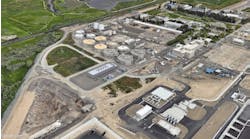Public Service Electric and Gas (PSE&G) has begun operating a waste water treatment microgrid in Caldwell, New Jersey, designed as part of a utility resiliency program that uses solar.
Located outside of New York City, the solar plus storage facility will serve the grid during normal conditions, and act as back-up generation for the treatment plant during a power outage.
Microgrids are increasingly being installed at wastewater treatment facilities to avert release of raw sewage into waterways should a power outage occur.
Speaking yesterday at a Bloomberg event in New York City that marked the fifth year anniversary of SuperStorm Sandy, New Jersey Gov. Chris Christie described the crisis that brought on construction of microgrids at waste water treatment plants.
Shortly after Sandy struck, Christie got word that few waste water treatment plants remained in operation because the electric grid was down. Almost the entire state had lost power, 2.8 million households.
He had to grant permission to dump millions of gallons of sewage a day into New Jersey waterways.
“I said, ‘What is the alternative?’ They said, ‘There really is no alternative. We have to do something with it.’ When you have to be that person who says dump raw sewage into our waterways, you think I never want anybody else to have to make this decision again. This is wrong.”
Five years later almost all of the state’s waste water treatment plants “now have separate grids,” Christie said, at the event sponsored by Siemens. “Desperation caused that.”
10 days of power from microgrid
In Caldwell, the new waste water treatment microgrid pairs a 250 kW/1 MWh battery system with 2,682 solar panels that generate 896-kW.
When an extended outage occurs, the solar, storage and existing diesel generators can power the treatment facility for up to 10 days. The solar panels recharge the batteries during the day and discharge at night.
During normal operations, the solar provides power and frequency response to regional grid operator PJM.
Siemens control technology monitors, manages and distributes power across the system. Siemens also integrated the microgrid’s batteries, solar and diesel. Eos Energy Storage provided the long-duration, zinc hybrid cathode batteries, which are being operated by A.F. Mensah. Advanced Solar Power acted as the engineering, procurement and construction contractor.
PSE&G is funding the microgrid through customer rates, as part of its “Solar 4 All” program, the impetus for 158-MW of large-scale, grid-connected solar projects, of which 124 MW are in operation. The New Jersey Board of Public Utilities approved utility spending for the program of $515 million in 2009; $247 million in 2013 and $275 million in 2016.
The utility applies revenue from the projects to offset costs to ratepayers. Revenue streams include the sale of solar energy and capacity to the grid, the sale of the solar credits (SRECs), and the federal investment tax credit.
Program for solar projects that offer resiliency
The waste water treatment microgrid is part of a special 3 MW carve out in Solar 4 All that is dedicated to resiliency projects. During Superstorm Sandy many of those with solar installations were surprised to find that they could not generate power unless they had a microgrid or advanced inverter.
As part of the carve out, the utility also has installed advanced solar plus storage systems at a high school and at a hospital.
[clickToTweet tweet=”NJ utility installs #microgrid at waste water plant @Siemens_DG ” quote=”NJ utility installs microgrid at waste water plant”]
“PSE&G has taken a number of major steps during the past several years to both harden our electric grid in the face of major storms and also make it more resilient,” said Courtney McCormick – vice president renewables and energy solutions, PSE&G. “The Caldwell wastewater treatment plant and our other solar storage projects around the state are an important part of that work because they all demonstrate how well-suited solar storage is for ensuring the reliability and resiliency of critical pieces of infrastructure.”
The project combines Siemens’ AC power conversion and intelligent controls with Eos’ modular energy stack design for quick deployment and ease of maintenance.
“This project is a leading example of the role technology can and should play in making our regions more resilient,” said Dan Wishnick, principal business developer, Siemens Medium Voltage Systems.
Track news about microgrids. Follow us on Twitter @MicrogridNews.






